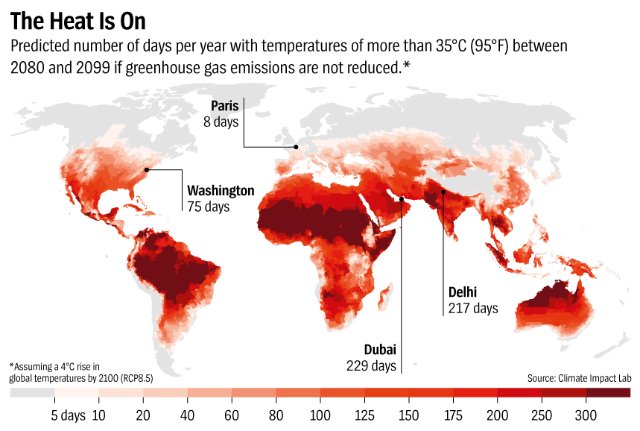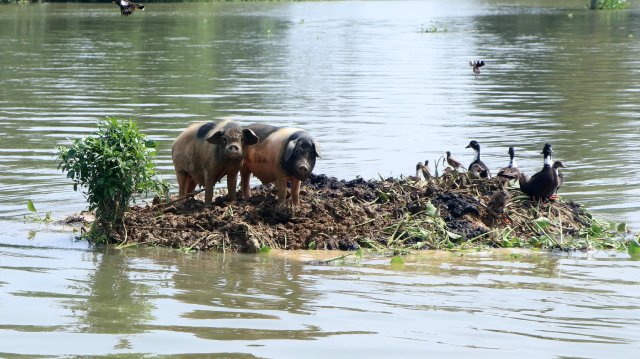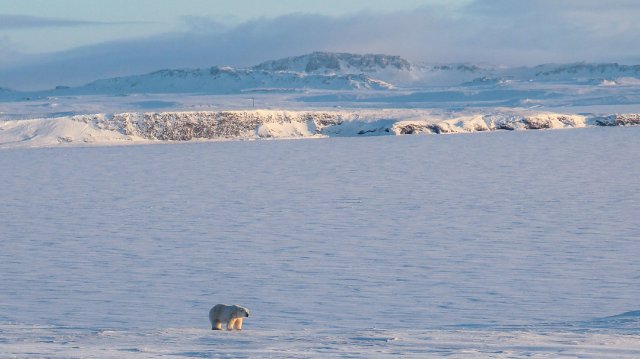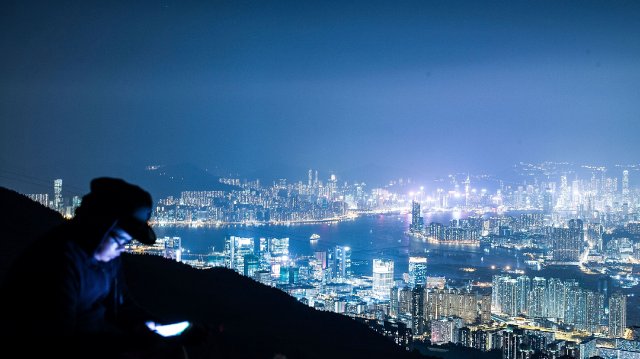www.aljazeerah.info
Opinion Editorials, September 2019
Archives
Mission & Name
Conflict Terminology
Editorials
Gaza Holocaust
Gulf War
Isdood
Islam
News
News Photos
Opinion Editorials
US Foreign Policy (Dr. El-Najjar's Articles)
www.aljazeerah.info
Scorched Earth: Cities Seek to Protect themselves from Climate Change By Marco Evers et al (Bartholomäus Grill, Laura Höflinger, Katrin Kuntz, Marc Pitzke, Maximilian Popp, Mathieu von Rohr and Raphael Thelen) Der Spiegel, September 30, 2019 |
 |
 |
|
Droughts have become a fact of life in many parts of Australia, such as here in New South Wales |
The consequences of global warming have long since become tangible in the form of heat waves, floods and droughts. Many cities are taking proactive measures to avoid the direst consequences, but things could get worse. A lot worse. By DER SPIEGEL Staff
Omar Saleh is standing on a rise on the banks of the Great Zab, a tributary to the Tigris, and looking out at a world that could be an indication of what the future holds. He points straight ahead to the south, where the Tigris flows and, behind it, the Euphrates -- the two great twin rivers of the Middle East. Between them is Mesopotamia, the storied region whose fertile soil once produced such great wealth that it spawned one of the first human civilizations, complete with grain storage facilities, a written language and cities. It is said to have been the home of the Hanging Gardens of Babylon. A region of plenty.
Today, Saleh sees only a drought-stricken landscape, burned brown by the sun. A dust devil spins soil into the air as the farmer looks on.
Later, Saleh's father Salem would rave about days gone by. Sitting in the modest hovel where he receives guests, he speaks of the tomato plants they would plant in March and continue harvesting all the way into December -- and of years in which they would sometimes bring in so much wheat and barley that they could hardly store it all. His son listens attentively. He knows the stories, but he isn't familiar with the bountiful harvests.
The okra plants that Saleh planted in one field should have long since reached shoulder height, but there has been so little rain that they are merely shriveling up on the ground. Melons, peppers, tomatoes: They've all died. Mesopotamia, one of the cradle of civilization, is today suffering from the effects of climate change.
And if it does rain, the water pours down so violently that it destroys everything. The source of Saleh's livelihood, the fertile dark earth, was washed away last year. "You look at your land and you have this feeling of helplessness as everything you have worked for over several months is destroyed, and there is nothing you can do," he says.
This destruction is a problem encountered far beyond the Middle East and it has long since afflicted other regions around the world. And the consequences could by much more dramatic, far-reaching and lasting than anything the civilized world has ever had to contend with.
Lethal Heat
For a long time, climate change was merely an abstract phenomenon for many people, one that future generations would be affected by, if at all. But the perception has changed dramatically in recent months. Heatwaves, droughts, storms, forest fires, floods: The consequences are becoming more visible all the time.
Indeed, it is becoming apparent that climate change won't be arriving at some point in the future. It is already here.
In Brazil, the Amazon rain forest is burning as landowners incinerate huge expanses for agriculture. They have been helped by the fact that the dry season came much earlier this year, making the forest more flammable. In the Indian region of Rajasthan, in Basra, Iraq, and in Dubai, temperatures of over 50 degrees Celsius (122 degrees Fahrenheit) were measured, a threshold being reached in more and more places -- and above which human life becomes impossible.
July was the hottest month on record. In the town of Lingen, in the German state of Lower Saxony, the temperature rose to 42.6 degrees Celsius and many other places in Europe experienced similar heat. In France, several nuclear reactors had to be throttled down because the rivers from which they drew their cooling water would have otherwise become too warm. Dutch towns spread salt on the roads to cool them.
Around 200 million people around the world live in some 350 cities that are dealing with temperatures higher than 35 degrees Celsius. In the next 30 years, forecasts suggest that the number of cities in that category will nearly triple. Already today, more people die from heat than from all other extreme weather phenomena combined.
What will happenif this trend continues? What if the heat waves last longer, the storms become more frequent and the flooding more dramatic?
Humanity's Most Pressing Question
Since the beginning of industrialization in the second half of the 18th century, humans have released so much CO2 into the atmosphere that the global average temperature has increased by around 1 degree Celsius. And temperatures currently continue to rise by a further 0.2 degrees each decade.
The Arctic region has been affected the most by the warming climate. It is already 3 degrees Celsius warmer than it was 100 years ago, which has clear consequences for our weather. Around the world, the years since 2014 have been the warmest since recordkeeping began.

The effects of climate change can now be felt in all parts of the world. India this year saw more severe flooding than usual.
And yet there are still those who refuse to see what is happening before their very eyes or deny that it is being caused by human activity. This, too, is one reason why young people around the world are taking to the streetsto demand action. The Fridays for Future movement has transformed climate change into a new social issue.
This week saw world leaders gather in New York at the invitation of United Nations Secretary General António Guterres. Once again, the question as to how global warming should be addressed took center stage. It is the most important question facing humanity in the 21st century.
It is the task of the Intergovernmental Panel on Climate Change to find answers to that question. The panel was founded in 1988 under the auspices of the UN and includes 195 countries. Thus far, the IPCC has produced five Assessment Reports, with the sixth currently set for completion in 2022. They are often thicker than the Bible and take several years to produce. Hundreds of experts are involved: They review and evaluate studies and discuss findings with each member state. The result is an appraisal that doesn't reflect individual viewpoints, but the consensus of all those involved, laid out in sober prose. It makes for shocking reading.
Two Degrees Too Many
In October 2018, the IPCC issued a Special Report exploring the question as to whether the world will meet the target of limiting global warming to 1.5 degrees Celsius relative to pre-industrial times -- a target formalized in the 2015 Paris Agreement. The conclusion: Every country in the world must do more. A lot more.
According to the IPCC, there is only one way to meet the 1.5-degree goal: Global CO2 emissions must be almost halved by 2030. By 2055 at the latest, they must reach "net zero." That means that if CO2 is released at all, the same amount must then be removed from the atmosphere. If the climate were to warm by 2 degrees Celsius, which the Paris deal formulates as a fallback, the future of humanity looks much darker.
Two degrees would mean a complete destruction of the coral reefs, huge crop losses, the melting of the Greenland icepack and mortal danger to millions of people. Cities, once built to protect people from the elements, would be hit particularly hard. Currently, more than half of the global population lives in cities.
Cars, airplanes, factories and agriculture produce vast amounts of CO2 each year, along with other greenhouse gases -- all of which form a layer around the earth that prevents the sun's energy from escaping. CO2 concentration is measured in parts per million (ppm), with 400 ppm long having been seen as cause for concern. That level was reached in 2013 -- for the first time in at least 3 million years. And the consequences can already be seen, with many places experiencing rising temperatures, especially cities, which tend to heat up more quickly.
The 'Heat Island Effect'
Only about one-tenth of the area of Paris is covered with parks and other green spaces, the lowest share among European capitals. In London, it is a third. "Paris wasn't planned to handle such conditions," says François Dagnaud, mayor of the 19th Arrondissement. In summer, gusts of wind only rarely blew through the streets, and when they did, they were so warm that they brought little relief.
The phenomenon that Paris will increasingly suffer from is referred to by scientists as the "heat island effect." It generally has three causes. For one, vegetation and bodies of water have a cooling effect through evaporation, and there is a lack of both in many cities. Secondly, dark patches such as asphalt reflect less sunlight than lighter-colored areas, and they give off heat as they warm. Finally, cars, air conditioners and construction machinery also give off heat. Combined, they result in cities being up to 10 degrees Celsius warmer than the surrounding countryside, a problem that is especially evident in rapidly growing metropolitan areas. Beijing and Tokyo, for example, have warmed five times faster than their surroundings in the last 100 years, whereas Madrid has only warmed 1.5 times as quickly.

Some of the most dramatic effects of climate change can be seen in the Arctic, where temperatures are rising faster than elsewhere.
The year 2003 provided a prime example for what can happen when Europe is hit by a heat wave. Like this summer, it was a year in which a slew of temperature records fell, with 40.2 degrees Celsius being measured in Freiburg, 44.1 degrees in two villages in southern France and 47.4 degrees in the Portuguese town of Amareleja. Hospitals in Paris filled up and doctors had to treat patients in the hallways. The morgues couldn't handle all of the bodies, with refrigerated warehouses forced to take up the slack.
Within just a few weeks in France, fully 15,000 more people died than average death rates would have otherwise accounted for. In Germany, it was 7,000, and 70,000 across Europe -- making the 2003 heatwave one of the deadliest natural catastrophes ever on the Continent. And the frequency of such heatwaves is on the rise.
Hotter and More Humid
In the Indian metropolis of Delhi, with its population of almost 19 million, the thermometer registered a temperature of 48 degrees Celsius in June, also a record. In Churu, a town on the edge of the desert in Rajasthan, it was 50.8 degrees.
High temperatures on their own aren't the problem. Not only is Delhi experiencing extreme temperatures more frequently, but the climate has also become more humid in recent years. The heat index, which includes relative humidity, has climbed by 0.6 degrees in Delhi every decade since the 1950s. Heat combined with humidity is much more difficult for the human body to deal with than heat on its own. Clothes stick to your body and the wind is hot as well, while the asphalt melts under your shoes.
There are regions of the world, such as the Gulf states, that faces similarly adverse conditions. But on average, people there have far more money, and with it, the ability to buy their way out of the worst. In Delhi, meanwhile, emergency rooms fill up in the summer with victims of the extreme temperature. They complain of stomach pains and diarrhea because food spoils more quickly in the heat. They suffer from dizziness, headaches and nausea -- the symptoms of heat stroke -- and then head off to work the next morning anyway. Because if you are sick in India, you generally won't get paid.
A temperature of 48 degrees Celsius would shut down most European countries, but in Delhi, workers just tie wet kerchiefs around their heads and head back to work carrying heavy loads or pulling rikshaws through the streets. Only a tiny minority of Indians can afford an air conditioning unit, and many are forced to make do without even a refrigerator.
Subheader
Should global warming continue apace, scientists at the Massachusetts Institute of Technology have calculated that fully 70 percent of the population of India could be exposed to periods of extreme heat by the end of the century. Scientist Krishna AchutaRao, of the Indian Institute of Technology in Delhi, believes that his hometown could pass the 50-degree mark one day.
The climbing temperatures have an additional effect. Warm air stores more moisture, and greater humidity leads to more rainfall -- which in turn results in the kinds of flooding that recently turned the northeastern Indian village of Murkata into an island. Only a few structures on elevated ground are still reachable. As the water level rose, the residents of Murkata say they knew what to do. They tied up their clothes in empty rice sacks and hung them from the beams of their homes. Important things like documents, pots and rice, they took with them. They gathered their chickens and cows, built a bamboo raft for them and took them to safety.
In many parts of India, the rainy season is a period of happiness. But in the country's northeast, north of Bangladesh and south of Tibet, people have begun to fear the rain. During the four-month period starting in June, 80 percent of region's annual precipitation falls from the sky, frequently causing the Brahmaputra, one of the world's largest rivers, to burst its banks and cover huge areas under water. The floods, though, have become increasingly unpredictable. This year, millions of people in Nepal, Bangladesh and India were forced by the flood waters to temporarily flee their homes, thousands of schools were destroyed or damaged and fertile fields were devastated.
The Day the Water Runs Out
The region makes it abundantly clear what happens when the climate catastrophe strikes an area where the state has difficulty arranging for rapid aid. And it shows that it is primarily those people who have contributed the least to our changing climate that must suffer the most. That is one reason why industrialized countries, as primary contributors to global warming, have a duty to do more to help poor regions.
Hari Das Sarkar, a slight man aged somewhere between 50 and 60, is squatting on the edge of a road in Murkata as cars and trucks speed past. The road is the only bit of land in the area that is slightly elevated and thus remained dry. People have fashioned tents of bamboo on the shoulder of the arterial. The air is humid and babies are crying. There are no toilets. Children are playing in filth. The government has distributed emergency rations.
Sarkar doesn't know what climate change means; he's never heard the term before. But he senses that his world is changing. There used to be just one flood per year, he says, but lately, there have been two, or even three.
Climate change is transforming the entire world into a crisis area, though differently in each region. India has been afflicted, to be sure, but so has the southern tip of Africa. Temperatures in inland South Africa are already 2 degrees Celsius higher than they were 100 years ago, with a similar phenomenon having been observed in neighboring Botswana. The dry period is longer and longer, and when it does rain, it is increasingly in the form of torrential storms. But even as climate change looks slightly different everywhere you look, the consequences tend to be the same: chronic water shortages, paltry harvests and the death of livestock.
When it comes to cities, the residents of Cape Town got a closeup last spring of the kind of catastrophes that are in store for them. The city on the southern tip of the African continent found itself on the verge of becoming the first major city to run out of water. Following three winters in succession with the lowest measured rainfall in a century, the reservoirs were largely empty. It was the worst drought since 1933. It was only through drastic water conservation efforts that "Day Zero," the day on which there would be no water left at all, was avoided.
South African meteorologists say that climate change-induced waters shortages are "the new normal," something that Cape Town will have to learn to deal with, just as will cities like Sao Paulo, Los Angeles, Melbourne and others in drought-plagued regions. Because since the middle of the 20th century, the global population has tripled and water use is six times what it once was.
The New Normal
Such is the situation of the world in 2019, following just 1 degree of warming. From here, things could start moving quickly, a function of the so-called climate change feedback. Snow-covered glaciers reflect the rays of the sun back into space, while forests absorb and store CO2, as does permafrost in the Arctic tundra. Rising temperatures translate into melting glaciers, burning forests and thawing permafrost. More CO2 ends up in the atmosphere, which speeds up the warming -- resulting in the disappearance of more glaciers, forests and permafrost. It is a vicious cycle.
Permafrost alone stores twice as much carbon as is currently in the atmosphere, some of it as methane, with over a period of 20 years is up to 86 times more harmful to the climate than CO2. Around the world, glaciers are melting more quickly than predicted while on Russia's Yamal Peninsula, huge methane bubbles are pushing their way through the thawing permafrost and exploding. Forests are burning in the Arctic.
This brings the climate close to its so-called "tipping elements," components of the Earth system that "can be tipped into a qualitatively different state by small external perturbations" and can trigger a cascade effect, according to the Potsdam Institute for Climate Impact Research. One example is the melting West Antarctic Ice Sheet. It's not clear when the melting will become irreversible, but it will likely be sometime before 2100. Indeed, there are a number of such tipping elements. And if their thresholds are exceeded, global warming will no longer be linear, but exponential.
The World Bank has forecast what would happen if these cascade effects were to come to pass: Extreme weather events, some of which have yet to reveal themselves, could become the norm in the coming decades. Heat waves of unknown proportions could hit the Middle East, Latin America and Europe.
High Stakes
In Germany, hot summers like the one in 2003 would no longer be anomalies. Parts of southern Europe would turn into deserts. The Ganges, a source of life for 500 million people in India, could dry up. Sea levels would rise and cities with over a million inhabitants, such as Alexandria or Jakarta, would sink. Storms like Hurricane Sandy, which flooded New York in 2012, would increase in number and forest fires would devastate even larger areas.
"Our response to the challenges of climate change will determine the legacy of our generation. The stakes have never been higher," the World Bank writes.
The existential threat to human life posed by climate change is increasingly penetrating the public consciousness. Experts see this as an opportunity: Humans were able to create a system that brought the Earth to the brink of collapse. We are entirely capable of designing a system that will save it. And there is an increasing number of indications that we will ultimately succeed.
In Great Britain, for example, amazing things have happened in recent years. Though its progress has been almost entirely overshadowed by Brexit, the UK has become a pioneer in climate protection. As early as 2008, it became one of the first major industrial countries to adopt a climate protection law with the Climate Change Act. This legislation stipulates an 80-percent reduction in greenhouse gas emissions by 2050 over 1990 levels.
In May of this year, the country's parliament also declared a national climate emergency, making it the first legislature in the world to do so. A month later, in June, Britain celebrated a record: For 18 days, six hours and 10 minutes, coal-fired power stations in the country produced not a single kilowatt hour of electricity.
Since the first coal-fired power plant went online in Great Britain in 1882, coal-fired power generation had never been interrupted for so long. It was a test run for the future. Until as recently as the 1970s, coal was still the country's most important source of energy. Today, it only accounts for 5 percent of the mix. Renewable energy sources make up 30 percent, nuclear power around 19.5 percent and gas just under 40 percent. By 2025, Great Britain plans to liberate itself completely from coal.
No Clear Targets
One of the reasons for the rapid departure from coal was the so-called Carbon Price Floor (CPF). Since April 1, 2013, electricity producers have had to pay a minimum price for every ton of CO2 they release into the atmosphere. Initially, this price exceeded the cost of CO2 certificates within the EU -- and business with coal became less attractive.
In the World Economic Forum's Energy Transition Index, Great Britain is today in seventh place, behind Sweden, Switzerland, Norway, Finland, Denmark and Austria. Germany is in 17th place.
In the latest index, published in July, experts wrote that the UK's climate goals would be achievable if Britons were to change their everyday behaviors. By 2050, they would have to eat around 20 percent less lamb, beef and dairy products and fly considerably less than before. Electricity would have to come entirely from renewable sources and no new buildings could be heated with gas. Additionally, from 2035 on, only electric cars should be sold. No such clear targets have been formulated for Germany.
It's a strange quirk of fate, says Alice Bell, that Great Britain, the motherland of industrialization, will be the global leader in phasing out coal. Bell is standing in the middle of London, not far from King's Cross station, and is surrounded by brick buildings, one of which is emblazoned with the words, "Coal Office." Some 150 years ago, this was one of the largest trans-shipment points for coal in London. Coal powered the machines in the factories, fueled trains everywhere and heated people's homes. Today, the space is occupied by children playing in fountains and gardeners watering geraniums.
"We're experiencing change everywhere," Bell says. Former gasometers have been converted into apartments, for instance, and Bell says that the city is full of such climate change-related stories. They just have to be told.
Bell works for a small environmental organization and has given tours of the city for years. She focuses on the history of the climate crisis and her tours sell out quickly. The first stop is the Royal Institution, where she tells the story of John Tyndall, a man who is considered one of the discoverers of the greenhouse effect, which he accomplished in 1859. Next, Bell walks across the Pall Mall, the city's first street to be illuminated by gas lanterns, then past the Royal Automobile Club and a statue of the polar explorer John Franklin. By the end, after two hours, she arrives at the Tate Modern, which is housed in an old oil-fired power station.
The message that Alice Bell conveys is optimistic: We can evolve. If we try hard, we can solve this problem.
It is a question of will, of politics, but above all, of money. Climate change is already costing cities across the world a lot of money. New York alone has budgeted $20 billion for "climate resilience" measures, including making rooftops greener, protections against heat damage, planting more trees and buying more low-emission buses.
Still an Optimist
But some of the more ambitious projects often face delays due to financial reasons. The Outer Harbor Gateway Barrier, for instance, an eight-kilometer-long barrier that would have sealed off New York Harbor from the Atlantic, will not be realized. Instead, those who can afford to do so are resorting to self-help. Even in New York, there is a two-tiered classist system of climate protection.
The new Whitney Museum on the Hudson River, designed by the star architect Renzo Piano, is three meters above the water, but the especially expensive works of art are displayed only on the upper floors. Flood gates, 25 centimeters thick, protect all access points.
The American Copper Buildings, two luxury skyscrapers located not far from the United Nations headquarters on the East River, are likewise flood-protected and have natural gas-powered generators on the 48th floor that are not connected to the city grid. Inside, 761 apartments could remain self-sufficient even in the event of an extreme situation, meaning refrigerators and power outlets would continue to function during city-wide power outages. Meanwhile, the number of "doomsday preppers" in the U.S. continues to grow. These are people who build bunkers, for instance, to protect themselves and their loved ones from wind, weather and nuclear wars. Often, these facilities are equipped with living rooms, bars or even swimming pools.
"Climate mathematics are brutally clear: The world cannot be healed within a few years, but if we do nothing, we could fatally wound it through sheer negligence by 2020," Hans Joachim Schellnhuber, the founding director of the Potsdam Institute for Climate Impact Research, said back in 2017.
Nevertheless, Schellnhuber conveys a sense of optimism. The world is in an era of exponential transformation, he says. In the U.S., CO2 emissions are falling despite a growing economy. And China's voracious hunger for energy is increasingly satiated by wind and hydroelectric power. Big investors are distancing themselves from oil companies. "There will always be those who bury their heads in the sand and ignore the dangers of climate change, but a much larger number of us are determined to overcome this inertia," Schellnhuber and other climate researchers wrote in the journal Nature. Despite everything, he's still an optimist.
***
Share the link of this article with your facebook friends
|
|
|
|
||
|
||||||



